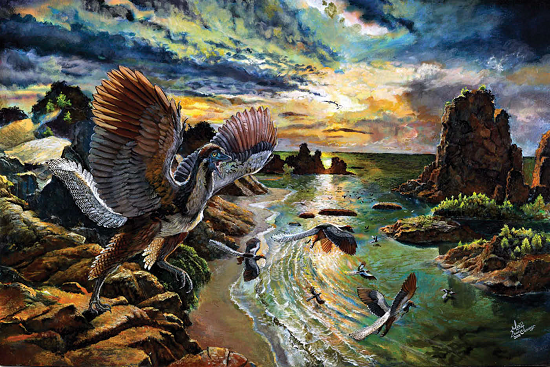New species of the ‘first bird’ Archaeopteryx uncovered

A new species of the famous ‘first bird’, Archaeopteryx, supporting its status as the transitional fossil between birds and dinosaurs, has been published in the journal Historical Biology.
Contrary to some previous studies, Archaeopteryx can now be conclusively shown to be a primitive bird antecedent, and an evolutionary intermediate between birds and dinosaurs, which possessed teeth and clawed fingers.
The new study also used state-of-the-art 3D X-ray analyses (Synchrotron microtomography) to virtually dissect the fossil and identify skeletal adaptions that would have helped Archaeopteryx albersdoerferito fly.
The fossil was made available for study by scientists, who after over seven years of research recognised it as a new species — Archaeopteryx albersdoerferi.
“Archaeopteryx albersdoerferi is one of the most important specimens of Archaeopteryx because it is around 400,000 years younger than any of the others found so far,” noted lead author Martin Kundrát from the University of Pavol Jozef Šafárik, Slovakia.
“This is the first time that numerous bones and teeth of Archaeopteryx were viewed from all aspects including exposure of their inner structure. The use of synchrotron microtomography was the only way to study the specimen as it is heavily compressed with many fragmented bones partly or completely hidden in limestone”, Kundrát continued.
“Geochemical analysis of the rock encasing the bones implies this specimen came, unlike others, from the younger Mörnsheim Formation”, said Dr John Nudds from Manchester University, UK.
“Our analysis has shown that Archaeopteryx albersdoerferi shares more features in common with modern birds than their dinosaurian ancestors” said Professor Per Ahlberg of Uppsala University in Sweden.
These traits suggest that Archaeopteryx albersdoerferi may have possessed enhanced flying ability relative to geologically older species of Archaeopteryx.
The most remarkable included thin air-filled bones, increased area for attachment of flight muscles on the wishbone, and a reinforced configuration of bones in the wrist and hand. Archaeopteryx albersdoerferi also had fused bones in the skull and fewer teeth than other species of these ‘first birds’.
“Significantly, however, when we examined the evolutionary relationships of various species of Archaeopteryx we found that its flight-related characteristics had appeared separately from those of more advanced bird-line dinosaurs, implying that flying lifestyles have developed more than once” said Dr Benjamin Kear of Uppsala University.
“The specimen exhibits a mosaic accumulation of flight-supporting morphologies before it reached adulthood. Whether this trend is applicable for other basal birds, it will need to be studied when more virtual data are available,” added Kundrát.
Ultimately, these findings have uncovered a possible evolutionary mechanism through which flight-supporting characteristics developed during the evolution of dinosaurs, with Archaeopteryx in particular, having independently acquired increasingly bird-like traits over time.
The 150-million-year-old fossils of Archaeopteryx have been known since 1861, with 12 specimens recovered to date. The fossil in this study, the 8th or Daiting Specimen is of the most mysterious.
It was reportedly discovered in a quarry near Daiting in southern Germany in 1990 but has been held in private ownership until its purchase by palaeontologist Raimund Albersdoerfer in 2009.
*****
The lead author dedicates this article to co-author Lü Junchang, who unexpectedly passed away before this press release.

 China
China